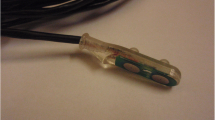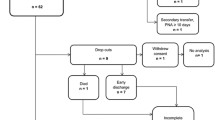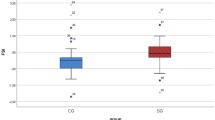Abstract
Purpose
Non-stress test (NST) is known as one of the most common assessments for evaluation of fetus well being. Since the prevalence of its false positive results is high and majority of fetuses with non-reactive results are not at risk, it is important to find out effective approaches to identify such results to avoid unnecessary interventions. So this survey was conducted with the aim of comparing the effects of acoustic stimulation with feeding mothers stimulation on non-reactive NST results.
Subjects and methods
This study preformed on 104 healthy pregnant women with non-reactive NST results and gestational ages between 32 and 42 weeks in Tabriz Alzahra hospital. Subjects were divided into two groups for acoustic stimulation and feeding mother stimulation. Half an hour later NST repeated for participants of each group in the same environmental condition and again the results evaluated.
Results
According to our findings, 75 % of subjects with non-reactive NST results changed to reactive after acoustic stimulation group. However, 80 % of participants with non-reactive NST results changed into reactive after feeding stimulation. No significant differences found while comparing test results.
Conclusion
Both stimulating approaches were effective in the identification of false positive NSTs and might be useful in preventing the unnecessary interventions.
Similar content being viewed by others
References
Behraman RE (2008) Nelson essentials of pediatrics. Arjmand Publication, Tehran, pp 210–211
Velazquez MD, Rayburn WF (2002) Antenatal evaluation of the fetus using fetal movement monitoring. Clin Obstet Gynecol 45(4):993–1004
Menihan CA, Kopel E (2007) Electronic fetal monitoring: concepts and applications. Lippincott Williams and Wilkins, Philadelphia, pp 65–68
Zuspan FP, Zuspan EJ (1994) Current therapy in obstetrics and gynecology. Saunders, Philadelphia, p 287
Jams DK, Steer PJ, Weiner CP, Gonic B (2000) Highrisk pregnancy. WB Saunders Company, Philadelphia, pp 11–12
Hasanzadeh M (2003) Evaluating the association between mother’s position and Non stress test results among hospitalized pregnant women in Tabriz Alzahra educational and treatment center. Master thesis Tabriz University of medical sciences faculty of midwifery
Christopher R, Harman SM, Frank AM (2000) Assessing fetal health. In: James DK, Steers PJ, Weinter CP, Gonik B (eds) High risk pregnancy. W.B Saunders Company, Philadelphia, p 253
Ling F, Duff P (2001) Obstetrics and Gynecology, McGraw-Hill, New York, pp 9–46
Boby P (2003) Multiple assessment techniques education antepartum fetal risk. Pediatr Ann 32:609–632
Gabbe GS, Niebyl RJ, Simposn J (2002) Obstetrics normal and problem pregnancies, 4th edn. Saunders, Philadelphia, pp 33–324
Gilbert E, Hamon J (2003) Manual of high risk pregnancy and delivery. Mosby, Saint Louis, pp 605–620
Fanaroff A, Richard J (2002) Disease of the fetus and infant, Neonate- Perinatal Medicine. Mosby, Saint Louis, pp 300–322
Caningham FG (2001) Intrapartum assessment. In: Obstetrics W (ed) Appleton and large United States. Asimon and Schuster Company, New York, pp 1330–1359
Sarinoglu F, Sshin I, Turkkani B (1999) The predictive value of fetal acoustic stimulation. J Perinatol 19:103–105
Sciscion A, Jonson T (1996) Fetal respons to vibroacostic. Medical Economic Company, USA, pp 1100–1150
Winn H, Hobins J (2000) Clinical maternal-fetal medicine. Parthenon Publishing Group, UK, pp 20–700
Modares M (2008) Comparison the results of non reactive non stress test after acoustic stimulation during fetal health assessment M. Modares Tehran University of medical sciences
Goldstein I, Makhoul IR, Nisman D, Tamir A, Escalante G, Itskovitz-Eldor J (2003) Influence of maternal carbohydrate on fetal movments at 14 to 16 weeks of gestation. Prenat Diagn 23(2):95–97
Bikas A (2008). Evaluation the influence of mothers fasting on non stress test results, Doctoral thesis Tabriz University of medical sciences
Xi Q, Du J, Liu X, Ling Shao J (2011) Clinical study on detecting false non-reactive of non-stress test by improved acoustic stimulation. Arch Gynecol Obstet 284:271–274
Dr. Fakhari (2003–2004), Comparison the prediction results of fetal distress during active phase of confinement with or without using vibrating acoustic stimulation, Kermanshah University of medical sciences
Acknowledgements
This paper is a result of MRS Shiva Raouf thesis graduate student from Aras University of Medical Sciences (International unit). Researchers wish to thank personal of Tabriz Al-Zahra Hospital for their helpful assistance.
Conflict of interest
All authors said that they have no conflict of interest.
Author information
Authors and Affiliations
Corresponding author
Rights and permissions
About this article
Cite this article
Hasanpour, S., Raouf, S., Shamsalizadeh, N. et al. Evaluation of the effects of acoustic stimulation and feeding mother stimulation on non-reactive non-stress test: a randomized clinical trial. Arch Gynecol Obstet 287, 1105–1110 (2013). https://doi.org/10.1007/s00404-012-2695-6
Received:
Accepted:
Published:
Issue Date:
DOI: https://doi.org/10.1007/s00404-012-2695-6




